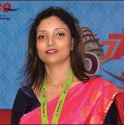Translate this page into:
Women in Indian Ophthalmology

*Corresponding author: Haimanti Choudhury, Department of Cataract and Oculoplasty Services, Choudhury Eye Hospital and Research Centre, Silchar, Assam, India. journal.osa@gmail.com
-
Received: ,
Accepted: ,
How to cite this article: Choudhury H. Women in Indian ophthalmology. J Ophthalmic Res Pract 2023;1:1-2.
As I pen my first Editorial, my heart beams with joy and gratitude as we have fulfilled the long-cherished dream of having an official Journal of Ophthalmological Society of Assam (OSA). Journal of Ophthalmic Research and Practice (JORP) is the fruit of whole hearted support of the Executive members of OSA under the leadership of President Dr. Subhra Kinkor Goswami. JORP is an open access peer reviewed journal dedicated to publishing standard articles in the field of ophthalmology. JORP has a full-fledged online manuscript management portal and peer review process. Details of manuscript preparation and submission are available in the journal website https://jophthalmicrespract.org/. The journal will be published bi-annual in online and print (limited) versions. While the online versions will be open to millions of ophthalmic research enthusiasts, the print version will be made available to all OSA members free of cost.
I take this opportunity to invite ophthalmic researchers, academicians, and clinicians across the world to submit their original work of research to JORP. A common and frequently asked query among researchers is the status of journal indexing. Indexing involves a process and cannot happen overnight.[1] It depends on the quality, publicly available peer review policies and regularity of the journal. All journals are non-indexed to begin with.[2] With your support and contribution, we do believe we will get JORP indexed in recognized indexing systems. Researchers would agree, that even if the journal is not indexed, getting it published by a reputed publisher is certainly a first step toward the process. This in itself is a mark of authenticity and ethics.
When I embarked on this editorial journey, I realized that there has been a substantial growth in the number of women in ophthalmology, or to be more precise women in ophthalmic research. Quite interestingly, the major chunk of submissions (71.4%) in the launch issue has been from female researchers. As a life affiliated society of All India Ophthalmological Society (AIOS), we studied the gender diversity in All India Ophthalmological Conferences (AIOC) over the past one and half decade. Way back in 2007 (my debut year in AIOC), 14% of women chaired the session (18 out of 128 sessions)[3] which rose to 22.3% (48 out of 215 sessions) in 2015.[4] The number doubled to 28.2% (77 out of 273 sessions) in 2022. When we looked at the number of women at the podium in AIOC, it suggested a trend toward gender inclusion. In 2010 AIOC, 19.46% of women were seen in faculty roles which stood at 28.2% in 2022.[5] A rather encouraging number was seen when we evaluated the number of free paper presenters at AIOC. In 2015, 38.79% (109 out of 281)[4] were women presenters which took a steep rise to break the gender bias in 2022 at 58.65% (200 out of 341).[6] Patel et al. studied the gender of presenters in ophthalmology conferences from 2015 to 2017 and found 30.5% speakers were women.[7]
While talking on academic role of women, it would be unfair to not speak on women in organizational capacity of AIOS. Dr. A. B. Laker was the first woman president of AIOS in 1954, followed by Dr. Sudha Sutaria in 1991, Dr. Vasundhara Kalevar in 1997 and Dr. Anita Panda in 2013.[8] However, AIOS had to wait for 75 years before getting its first women Honorary General Secretary (GS) in 2018.[9] Dr. Namrata Sharma became the first lady to take charge as the GS of the society and now she has adorned the position of Chairman Scientific Committee as a first. Despite the President and GS roles being taken by women ophthalmologist in India, the number of editor-in-chief of indexed ophthalmology journal in India are few. Indian Journal of Ophthalmology is yet to have a female editor-in-chief since its inception in 1952.[4] Park et al. conducted a study on representation of women in editorial boards of ophthalmology journals globally. He reported women accounted for 17% of editor-in-chief, 25% as editor (section, associate, assistant) and 22% as advisors in editorial board.[10] This figure certainly seems to be an improvement from 2018, when Camacci et al. found that 95.8% of editor-in-chief of major ophthalmology journals were men.[11]
For this launch issue, we have tried to put together original articles, review articles, and interesting cases from most sub specialties of ophthalmology. I do believe, it will be an enriching read for all. I shall be in anticipation of your valuable contribution to JORP.
References
- Report on Sunayana 2007: 65th Annual Conference of the All-India Ophthalmological Society. Exp Rev Ophthalmol. 2007;2:341-2.
- [CrossRef] [Google Scholar]
- Available from: https://www.aios-scientificcommittee.org/annual-conference/aioc-2015/Program Book 2015
- Abstracts 2010: 68th Annual Conference of All India Ophthalmological Society, Jan 21-24, 2010, Kolkata.
- [Google Scholar]
- Available from: https://www.aios-scientificcommittee.org/annual-conference/aioc-2022-2/Program Book 2022
- Gender of presenters at ophthalmology conferences between 2015-2017. Am J Ophthalmol. 2020;213:120-4.
- [CrossRef] [PubMed] [Google Scholar]
- Representation of women in ophthalmology journal editorial boards. BMJ Open Ophthalmol. 2022;7:e001127.
- [CrossRef] [PubMed] [Google Scholar]
- Association between sex composition and publication productivity of journal editorial and professional society board members in ophthalmology. JAMA Ophthalmol. 2020;138:451-8.
- [CrossRef] [PubMed] [Google Scholar]





